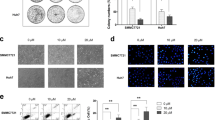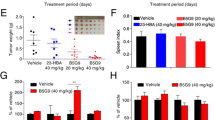Abstract
3-bromopyruvate (3-BP), a hexokinase (HK) II inhibitor, promotes tumor cell death by inducing endoplasmic reticulum (ER) stress in human hepatocellular carcinoma (HCC) cell lines. Protein disulfide isomerase (PDI) is an essential folding catalyst and attenuates ER stress by folding the misfolded proteins. We examined if PDI is expressed in hypoxic HCC cells, and evaluated its inhibition potentiated HK II inhibitor-induced ER stress in hypoxic HCC cells. HCC apoptotic cell death was assessed by DAPI staining and apoptotic signaling pathways were explored by immunoblot analysis. An in vivo model of HCC was established in C3H mice intradermally with implanted MH134 cells. 3-BP with/without a PDI inhibitor (bacitracin) was subsequently administered. The anti-tumor efficacies were evaluated by measuring tumor volumes and quantifying apoptotic cells and microvessel densities (MVDs). HCC cells were found to express PDI in a hypoxia-inducible manner. The simultaneous treatment of bacitracin and 3-BP enhanced 3-BP-induced apoptosis. This enhancement was attributed to increased ER stress and JNK activation compared to the cells treated with just 3-BP. In an in vivo model of HCC, tumor growth was significantly suppressed in mice co-treated with bacitracin and 3-BP, and the percentages of apoptotic cells significantly increased and MVDs significantly decreased. These results demonstrated that PDI was induced in hypoxic HCC tissue and that PDI inhibition enhanced HK II inhibitor-induced anti-tumor efficacy synergistically via augmenting ER stress and anti-angiogenesis in vivo. Thus, blockage of PDI activity in combination with HK II inhibitor may be therapeutically useful in HCCs.
Similar content being viewed by others
References
Beal SL (1984) Population pharmacokinetic data and parameter estimation based on their first two statistical moments. Drug Metab Rev 15(1–2):173–193
Briggs JN (1957) Staphylococcic pneumonia in infants and young children. Can Med Assoc J 76(4):269–272
Bustamante E, Morris HP, Pedersen PL (1981) Energy metabolism of tumor cells. Requirement for a form of hexokinase with a propensity for mitochondrial binding. J Biol Chem 256(16):8699–8704
Chignard N, Shang S, Wang H, Marrero J, Brechot C, Hanash S et al (2006) Cleavage of endoplasmic reticulum proteins in hepatocellular carcinoma: Detection of generated fragments in patient sera. Gastroenterology 130(7):2010–2022
Di Bisceglie AM, Rustgi VK, Hoofnagle JH, Dusheiko GM, Lotze MT (1988) NIH conference. Hepatocellular carcinoma. Ann Intern Med 108(3):390–401
Dickerhof N, Kleffmann T, Jack R, McCormick S (2011) Bacitracin inhibits the reductive activity of protein disulfide isomerase by disulfide bond formation with free cysteines in the substrate-binding domain. FEBS J
Drake CJ, Cheresh DA, Little CD (1995) An antagonist of integrin alpha v beta 3 prevents maturation of blood vessels during embryonic neovascularization. J Cell Sci 108(Pt 7):2655–2661
Feng Y, Tian ZM, Wan MX, Zheng ZB (2007) Protein profile of human hepatocarcinoma cell line SMMC-7721: identification and functional analysis. World J Gastroenterol 13(18):2608–2614
Ganapathy-Kanniappan S, Vali M, Kunjithapatham R, Buijs M, Syed LH, Rao PP et al (2010a) 3-bromopyruvate: a new targeted antiglycolytic agent and a promise for cancer therapy. Curr Pharm Biotechnol 11(5):510–517
Ganapathy-Kanniappan S, Geschwind JF, Kunjithapatham R, Buijs M, Syed LH, Rao PP et al (2010b) 3-Bromopyruvate induces endoplasmic reticulum stress, overcomes autophagy and causes apoptosis in human HCC cell lines. Anticancer Res 30(3):923–935
Goplen D, Wang J, Enger PO, Tysnes BB, Terzis AJ, Laerum OD et al (2006) Protein disulfide isomerase expression is related to the invasive properties of malignant glioma. Cancer Res 66(20):9895–9902
Graven KK, Molvar C, Roncarati JS, Klahn BD, Lowrey S, Farber HW (2002) Identification of protein disulfide isomerase as an endothelial hypoxic stress protein. Am J Physiol Lung Cell Mol Physiol 282(5):L996–L1003
Gwak GY, Yoon JH, Kim KM, Lee HS, Chung JW, Gores GJ (2005) Hypoxia stimulates proliferation of human hepatoma cells through the induction of hexokinase II expression. J Hepatol 42(3):358–364
Jordan PA, Gibbins JM (2006) Extracellular disulfide exchange and the regulation of cellular function. Antioxid Redox Signal 8(3–4):312–324
Kim W, Yoon JH, Jeong JM, Cheon GJ, Lee TS, Yang JI et al (2007) Apoptosis-inducing antitumor efficacy of hexokinase II inhibitor in hepatocellular carcinoma. Mol Cancer Ther 6(9):2554–2562
Kim W, Yoon JH, Kim JR, Jang IJ, Bang YJ, Kim YJ et al (2009) Synergistic anti-tumor efficacy of lovastatin and protein kinase C-beta inhibitor in hepatocellular carcinoma. Canc Chemother Pharmacol 64(3):497–507
Ming LJ, Epperson JD (2002) Metal binding and structure-activity relationship of the metalloantibiotic peptide bacitracin. J Inorg Biochem 91(1):46–58
Moenner M, Pluquet O, Bouchecareilh M, Chevet E (2007) Integrated endoplasmic reticulum stress responses in cancer. Cancer Res 67(22):10631–10634
Mori K (2000) Tripartite management of unfolded proteins in the endoplasmic reticulum. Cell 101(5):451–454
Parkin DM, Pisani P, Ferlay J (1999) Estimates of the worldwide incidence of 25 major cancers in 1990. Int J Cancer 80(6):827–841
Pastorekova S, Zatovicova M, Pastorek J (2008) Cancer-associated carbonic anhydrases and their inhibition. Curr Pharm Des 14(7):685–698
Puig A, Lyles MM, Noiva R, Gilbert HF (1994) The role of the thiol/disulfide centers and peptide binding site in the chaperone and anti-chaperone activities of protein disulfide isomerase. J Biol Chem 269(29):19128–19135
Rapisarda A, Melillo G (2009) Role of the hypoxic tumor microenvironment in the resistance to anti-angiogenic therapies. Drug Resist Updates 12(3):74–80
Ron D, Walter P (2007) Signal integration in the endoplasmic reticulum unfolded protein response. Nat Rev Mol Cell Biol 8(7):519–529
Roth RA (1981) Bacitracin: an inhibitor of the insulin degrading activity of glutathione-insulin transhydrogenase. Biochem Biophys Res Commun 98(2):431–438
Soldi R, Mitola S, Strasly M, Defilippi P, Tarone G, Bussolino F (1999) Role of alphavbeta3 integrin in the activation of vascular endothelial growth factor receptor-2. EMBO J 18(4):882–892
Swiatkowska M, Szymanski J, Padula G, Cierniewski CS (2008) Interaction and functional association of protein disulfide isomerase with alphaVbeta3 integrin on endothelial cells. FEBS J 275(8):1813–1823
Szegezdi E, Logue SE, Gorman AM, Samali A (2006) Mediators of endoplasmic reticulum stress-induced apoptosis. EMBO Rep 7(9):880–885
Tager M, Kroning H, Thiel U, Ansorge S (1997) Membrane-bound proteindisulfide isomerase (PDI) is involved in regulation of surface expression of thiols and drug sensitivity of B-CLL cells. Exp Hematol 25(7):601–607
Tezuka M, Hayashi K, Kubota K, Sekine S, Okada Y, Ina H et al (2007) Growth rate of locally recurrent hepatocellular carcinoma after transcatheter arterial chemoembolization: comparing the growth rate of locally recurrent tumor with that of primary hepatocellular carcinoma. Dig Dis Sci 52(3):783–788
Tian F, Zhou X, Wikstrom J, Karlsson H, Sjoland H, Gan LM et al (2009) Protein disulfide isomerase increases in myocardial endothelial cells in mice exposed to chronic hypoxia: a stimulatory role in angiogenesis. Am J Physiol Heart Circ Physiol 297(3):H1078–H1086
Trevisani F, Caraceni P, Bernardi M, D’Intino PE, Arienti V, Amorati P et al (1993) Gross pathologic types of hepatocellular carcinoma in Italian patients. Relationship with demographic, environmental, and clinical factors. Cancer 72(5):1557–1563
Weinstein-Oppenheimer CR, Henriquez-Roldan CF, Davis JM, Navolanic PM, Saleh OA, Steelman LS et al (2001) Role of the Raf signal transduction cascade in the in vitro resistance to the anticancer drug doxorubicin. Clin Cancer Res 7(9):2898–2907
Xu C, Bailly-Maitre B, Reed JC (2005) Endoplasmic reticulum stress: cell life and death decisions. J Clin Invest 115(10):2656–2664
Yamashita YI, Shimada M, Hasegawa H, Minagawa R, Rikimaru T, Hamatsu T et al (2001) Electroporation-mediated interleukin-12 gene therapy for hepatocellular carcinoma in the mice model. Cancer Res 61(3):1005–1012
Yoon JH, Lee HS (2008) Experimental agents which inhibit hepatocarcinogenesis. Oncology 75(Suppl 1):17–21
Yu SJ, Yoon JH, Lee JH, Myung SJ, Jang ES, Kwak MS et al (2011) Inhibition of hypoxia-inducible carbonic anhydrase-IX enhances hexokinase II inhibitor-induced hepatocellular carcinoma cell apoptosis. Acta Pharmacol Sin 32(7):912–920
Zhou J, Zheng W, Cao L, Liu M, Han F, Li A (2010) Antiangiogenic tumor treatment: noninvasive monitoring with contrast pulse sequence imaging for contrast-enhanced grayscale ultrasound. Acad Radiol 17(5):646–651
Author information
Authors and Affiliations
Corresponding author
Rights and permissions
About this article
Cite this article
Yu, S.J., Yoon, JH., Yang, JI. et al. Enhancement of hexokinase II inhibitor-induced apoptosis in hepatocellular carcinoma cells via augmenting ER stress and anti-angiogenesis by protein disulfide isomerase inhibition. J Bioenerg Biomembr 44, 101–115 (2012). https://doi.org/10.1007/s10863-012-9416-5
Received:
Accepted:
Published:
Issue Date:
DOI: https://doi.org/10.1007/s10863-012-9416-5




